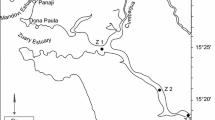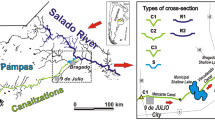Abstract
The potamoplankton of the Middle Loire was studied every two weeks from June to October 1997, a period of low water flow. The downstream increase in dissolved oxygen, suspended matter, BOD5 and chlorophyll a, and the decrease in nutrients were associated with algae growth, principally of chlorophytes and bacillariophytes. Algae reached maxima of 54 × 106 cells l−1 and 78 × 106 cells l−1 up- and downstream respectively. A large ciliate community of oligotrichs and peritrichs also developed, with densities up to 24 × 103 cells l−1 upstream and 49 × 103 cells l−1 downstream. These maxima were succeeded by large numbers of heterotrophic flagellates that reached 690 × 103 cells l−1 upstream following a peak of rotifers, and 2430 × 103 cells l−1 downstream following the ciliate maximum. Nevertheless, these flagellates constituted only a small proportion of the total protozoan biomass, which was dominated by ciliates. The autotrophic plankton remains the dominant component for most of the time, confirming that lowland rivers support significant phytoplankton production. The influence of anthropic disturbances on rotifer development was debated with regard to the results obtained in previous years. The maximum rotifers density, due to brachionids and trichocercids reached 3500 ind l−1 upstream and 2750 ind l−1 downstream, a decrease similar to that observed the previous year. In 1997, addition of suspended matter was probably responsible for the increase in food levels, which enhanced the development of the predators, thus illustrating that potamoplankton is largely dependent on trophic relationships and local influences, which highlights the need for a careful evaluation of all assessment criteria.
Similar content being viewed by others
References
Azam, F., T. Fenchel, J. S. Field, L. A. Meyer-Reil & F. Thingstad, 1983. The ecological role of water-column microbes in the sea. Mar. Ecol. Prog. Ser. 10: 257–263.
Baldock, B. M., J. H. Baker & M. A. Sleigh, 1983. Abundance and productivity of Protozoa in chalk streams. Holarct. Ecol. 6: 238–246.
Basu, B. K. & F. R. Pick, 1996. Factors regulating phytoplankton and zooplankton biomass in temperate rivers. Limnol. Oceanogr. 41: 1572–1577.
Basu, B. K. & F. R. Pick, 1997a. Phytoplankton and zooplankton development in a lowland, temperate river. J. Plankton Res. 19: 237–253.
Basu, B. K. & F. R. Pick, 1997b. Factors related to heterotrophic bacterial and flagellate abundance in temperate rivers. Aquat. Microb. Ecol. 12: 123–129.
Bergfeld, T., A. Schöl, V. Kirchesch & D. Müller, 1998. Flow-time concurring measurements of oxygen budget and biological processes in the rivers Moselle and Saar. Man and river systems. The functioning of river systems at basin scale. Presses E.N. Ponts et Chaussées: 42–43.
Berninger U. G., D. A. Caron, R. W. Santer & B. J. Finlay, 1991. Heterotrophic flagellates of planktonic communities, their characteristics and methods of study, in Patterson, D. J. & J. Larsen (eds), The Biology of Free-Living Heterotrophic Flagellates. Systematics Association 45: 39–56.
Bloem J., M. J. Bär-Gilissen & T.E. Cappenberg, 1986. Fixation, counting and manipulation of heterotrophic nanoflagellates. Apl. envir. Microbiol. 52: 1266–1272.
Bloem J. & M. J. Bär-Gilissen, 1988. Fixing nanoflagellates. Arch. Hydrob. Ergeb. Limno. 31: 275–280.
Bloem J. & M. J. Bär-Gilissen, 1989. Bacteria activity and protozoan grazing in a stratified lake. Limnol. Oceanogr. 34: 291–309.
Borsheim, K. Y. & G. Bratbak, 1987. Cell volume to cell carbon conversion factors for a bacterivorous Monas sp. enriched from seawater. Mar. Ecol. Prog. Ser. 36: 171–175.
Cabanes, P. A., E. Pringuez, F. Siclet, M. Khalanski & P. Pernin, 1997. Continuous chlorination to control pathogenic free-living amoebae in a closed-loop power plant. The Environ. Prof. 19: 192–200.
Carlough L. A & J. L. Meyer, 1989. Protozoans in two southeastern blackwater rivers and their importance to trophic transfer. Limnol. Oceanogr. 34: 163–177.
Carlough, L. A & J. L. Meyer, 1990. Rates of protozoan bactivory in three habitats of a south-eastern blackwater river. J. n. am. Benthol. Soc. 9: 45–53.
Caron, D. A., 1983. Technique for enumeration of heterotrophic and phototrophic nanoplankton, using epifluorescence microscopy, and comparison with other procedures. Apl. Envir. Microbiol. 46: 491–498.
Chessel, D. & S. Dolédec, 1992. ADE Software. Multivariate Analyses and Graphical Display for Environmental Data. Université Lyon I, 523 pp.
Del Giorgio, P. A. & J. M. Gasol, 1995. Biomass distribution in freshwater plankton communities. Am. Nat. 146: 135–152.
De Puytorac, P., J. Grain & J.-P. Mignot, 1987. Précis de protistologie. Ed Boubée, Paris: 581 pp.
De Ruyter Van Steveninck, E. D., W. Admiraal & B. Van Zanten, 1990. Changes in plankton communities in regulated reaches of the lower Rhine river. Regul. Riv. 5: 67–75.
De Ruyter Van Steveninck, E. D.,W. Admiraal, L. Breebaart, G. M. J. Tubbling & B. Van Zanten, 1992. Plankton in the River Rhine: structural and functional changes observed during downstream transport. J. Plankton Res. 14: 1351–1368
Descy, J.-P., 1987. Phytoplankton composition and dynamics in the river Meuse (Belgium). Arch. Hydrobiol. Suppl. 78.2: 225–245.
Descy, J.-P. & V. Gosselain, 1994. Development and ecological importance of phytoplankton in a large lowland river (River Meuse, Belgium). Hydrobiologia 289: 139–155.
Dolan, J. R. & C. L. Gallegos, 1991. Trophic coupling of rotifers, microflagellates, and bacteria during fall months in the Rhode River Estuary. Mar. Ecol. Prog. Ser. 77: 147–156.
Foissner, W. & H. Berger, 1996. A user-friendly guide to the ciliates (Protozoa, Ciliophora) commonly used by hydrobiologists as bioindicators in rivers, lakes, and wastewaters, with notes on their ecology. Freshwat. Biol. 35: 375–482.
Garnier, J., G. Billen & M. Coste, 1995. Seasonal succession of diatoms and Chlorophyceae in the drainage network of the Seine River: Observations and modelling. Limnol. Oceanogr. 40: 750–765.
Gilbert, J. J. & J. D. Jack, 1993. Rotifers as predators on small ciliates. Hydrobiologia 255/256: 247–253.
Gosselain, V., C. Joaquim-Justo, L. Viroux, M. Mena, A. Metens, J.-P. Descy & J.-P. Thome, 1996. Laboratory and in situ grazing rates of large river rotifers and their contribution to community grazing rates. Arch. Hydrobiol. Beih. 113 Large rivers 10: 353–361.
Gosselain, V., L. Viroux & J.-P. Descy, 1998. Can a community of small-bodied grazers control phytoplankton in rivers? Freshwat. Biol. 39: 9–24.
Gracia, M. Del P., C. Castellon, J. Igual & R. Sunyer, 1989. Ciliated Protozoa communities in a fluvial ecosystem. Hydrobiologia 183: 11–31.
Jakobsen, H. H. & P. J. Hansen, 1997. Prey size selection, grazing and growth response of the small heterotrophic dinoflagellate Gymnodinium sp. And the ciliate Balanion comatum - a comparative study. Mar. Ecol. Prog. Ser. 158: 75–86.
Jürgens, K. S. A. 1994. Impact of Daphnia on plankton microbial food webs - a review. Mar. Microb. Food Webs. 8: 295–324.
Jürgens, K., S. A. Wickham, K. O. Rothhaupt & B. Santer, 1996. feeding rates of macro-and microzooplankton on heterotrophic nanoflagellates. Limnol. Oceanogr. 41: 1833–1839.
King, C. H., E. B. Jr Shotts, R. E. Wooley & K. G. Porter, 1988. Survival of coliforms and bacterial pathogens within Protozoa during chlorination. Apl. envir. Microbiol. 54: 3023–3033.
Kirk, K. L., 1991. Suspended clay reduces Daphnia feeding rate, behavioural mechanisms. Freshwat. Biol. 25: 357–365.
Köhler, J., 1997. Measurement of in situ growth rates of phytoplankton under conditions of simulated turbulence. J. Plankton Res. 19: 849–862.
Lack, T. J., 1971. Quantitative studies on the phytoplankton of the rivers Thames and Kennet a Reading. Freshwat. Biol. 1: 213–224.
Lair, N., 1980. The Rotifer fauna of the river Loire (France) at the level of the nuclear power plants. Second Intern. Rotifers Symposium, Ghent, Belgium. Hydrobiologia 73: 153–160.
Lair, N. & D. Sargos, 1981. Dynamique des populations planctoniques en Loire moyenne. Ann. Stat. Biol. Besse-en-Chandesse 15: 60–114.
Lair, N. & H. Oulad Ali, 1990. Grazing and Assimilation rates of natural populations of planktonic Rotifers Keratella cochlearis, Keratella quadrata and Kellicottia longispina living in an eutrophic lake. Hydrobiologia 194: 119–131.
Lair, N. & D. Sargos, 1993. A 10 year study in the middle course of the River Loire. I - Patterns of change in hydrological, physical and chemical variables at the sites of nuclear power plants, in relation to algal biomass. Hydroecol. Appl. 5: 1–27.
Lair, N., J.-C. Léveillé, P. Reyes-Marchant & H. Taleb, 1994. The feeding of a larval fish, Lebistes reticulatus, on ciliates and rotifers. Mar. Microb. Food Webs. 8: 337–346.
Lair, N., D. Sargos & P. Reyes-Marchant, 1996a. Synthèse des études hydrobiologiques réalisées en Loire moyenne au niveau du site nucléaire de Dampierre-en-Burly (France). Hydroécol. Appl. 8: 35–84.
Lair, N., H. Taleb & & P. Reyes-Marchant, 1996b. The rotifer plankton of lake Aydat (France), a study of its horizontal distribution. Aquatic Sciences 58: 263–268.
Lair, N. & P. Reyes-Marchant, 1997. The potamoplankton of the Middle Loire and the role of the 'moving littoral' in downstream transfer of algae and rotifers. Hydrobiologia 356: 33–52.
Lair, N., P. Reyes-Marchant & V. Jacquet, 1998. Développement du phytoplancton, des Ciliés et des Rotifères sur deux sites de laLoire moyenne (France), en période d'étiage. Ann. Limnol. 34: 35–48.
Laybourn-Parry, J., 1992. Protozoan plankton ecology. Chapman et Hall. 231 pp.
Laybourn-Parry, J., M. Walton, M. Young, R. I. Jones & A. Shine, 1994. Protozooplankton and bacterioplankton in a large oligotrophic lake - Loch Ness, Scotland. J. Plankton Res. 16: 1655–1670.
Montel, M. L. & N. Lair, 1997. Relationships between heterotrophic nanoflagellates and the demographic response of Daphnia longispina in a eutrophic lake with poor food quality conditions. Freshwat. Biol. 38: 739–752.
Moss, B. & H. Balls, 1989. Phytoplankton distribution in a floodplain lake and river system. II. seasonal changes in the phytoplankton communities and their control by hydrology and nutrient availability. J. Plankton Res. 11: 839–867.
Peelen, R., 1975. Changes in the composition of the plankton of the rivers Rhine and Meuse in the Netherlands during the last fifty-five years. Verh. int. Ver. Limnol. 19: 1997–2009.
Pourriot, R., 1977. Food and feeding habits of the Rotifera. Arch. Hydrobiol. Beih. Ergbn. Limnol. 8: 243–260.
Pourriot, R., D. Benest, P. Champ & C. Rougier, 1982. Influence de quelques facteurs du milieu sur la composition et la dynamique saisonnière du zooplancton de la Loire. Acta OEcologica, OEcol. Gener. 3: 353–371.
Put, M. & D. K. Stoecker, 1989. An experimental determined carbon:volume ratio for marine "oligotrichous" ciliates from estuarine and coastal waters. Limnol. Oceanogr. 34: 1097–1103.
Reche, I., P. Carrillo & L. Cruz-Pizarro, 1997. Influence of metazooplankton on interactions of bacteria and phytoplankton in an oligotrophic lake. J. Plankton Res. 19: 631–646.
Reid, P. C., 1997. Discharges from Hydroelectric Power Schemes as a Trigger for marine Algal Blooms. Mar. Pollution Bull. 34: 730–733.
Reynolds, C. S., 1988. Potamoplankton: paradigms, paradoxes and prognoses. In F. E. Round (ed.), Algae and the Aquatic Environment. Biopress, Ltd. Bristol: 285–311.
Reynolds, C. S., J.-P. Descy & J. Padisak, 1994. Are phytoplankton dynamics in rivers so different from those in shallow lakes? Hydrobiologia 289: 1–7.
Reynolds, C. S. & J.-P. Descy, 1996. The production, biomass and structure of phytoplankton in large rivers. Arch. Hydrobiol. Beih. 113 'Large rivers' 10: 187–198.
Sherr, E. B., F. Rassoulzadegan & B. F. Sherr, 1989. Bactivory by pelagic choreotrichous ciliates in coastal waters of the N.W. Mediterranean Sea. Mar. Ecol. Prog. Ser. 55: 235–240.
Sime-Ngando, T. & C. Grolière, 1991. Effets quantitatifs des fixateurs sur la conservation des Ciliés planctoniques d'eau douce. Arch. Protistenkd. 140: 109–120.
Author information
Authors and Affiliations
Corresponding author
Rights and permissions
About this article
Cite this article
Lair, N., Jacquet, V. & Reyes-Marchant, P. Factors related to autotrophic potamoplankton, heterotrophic protists and micrometazoan abundance, at two sites in a lowland temperate river during low water flow. Hydrobiologia 394, 13–28 (1999). https://doi.org/10.1023/A:1003552021726
Issue Date:
DOI: https://doi.org/10.1023/A:1003552021726




